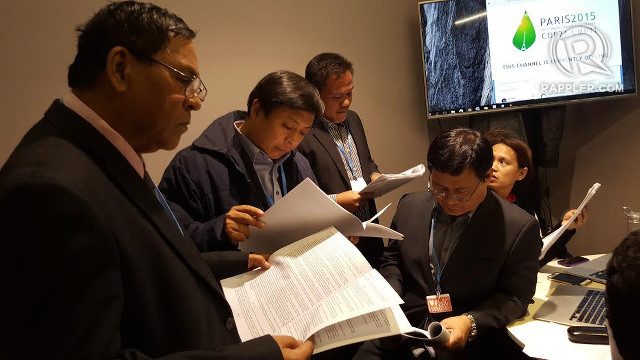SUMMARY
This is AI generated summarization, which may have errors. For context, always refer to the full article.

LE BOURGET, France – After the release of the near-final UN climate deal on Thursday night, December 10, the Philippine delegation faces its biggest obstacle so far: the exclusion of a provision that establishes liability and compensation for damages due to climate-linked disasters.
Option 2 in Article 5 of the draft agreement reads that addressing loss and damage associated with adverse effects of climate change should be done in a manner that “does not involve or provide a basis for liability or compensation.”
This is the strongest language so far that completely cuts off liability or compensation from the agreement. (READ: 4 crucial things PH wants from UN climate pact)
“As it is, we cannot accept that because we cannot mortgage the future, the rights of future victims,” said Philippine lead negotiator and spokesman Tony La Viña.
“Imagine if there’s a big storm 25 years from now, and someone should be held liable for what happens to them but we’ve mortgaged their right to go against that. That’s a text we want stricken out,” he explained.
Liability and compensation means certain entities, even countries, can be held liable for catastrophic damage to other countries because of their share of carbon emissions driving global warming. Thus, these countries may have to compensate the adversely affected nations.
It has always been among the most contentious issues in climate negotiations because developed countries like the US and European Union, two major carbon emitters, staunchly reject it.
But it’s the first time excluding the principle was so definitely stated in an option in the agreement.
‘Red line’ for PH
La Viña is confident that many other developing countries, not just the Philippines, will reject that part of the draft.
Another concern of the Philippine team is the “softening” of the reference to the 1.5°C warming limit goal, something the Philippines badly wants in the agreement.
In the new draft, 1.5°C is no longer in brackets but it appears amidst wording that is still too soft for the Philippines’ liking.
Under Article 2, it says that the world should strive to keep warming “well below 2°C above pre-industrial levels and to pursue efforts to limit the temperature increase to 1.5°C.”
La Viña said the Philippines prefers that the warming cap should explicitly be “below 1.5°C.”
As of posting, the delegation is preparing for the 11:30 pm gathering of lead country negotiators to be chaired by COP21 president and French foreign minister Laurent Fabius.
Called an “Indaba” in COP lingo, the gathering is meant to bring all countries together to tease out the remaining sticky issues and forge consensus.
This 11:30 pm Indaba may be the last such meeting before the release of the final UN climate pact.
La Viña said the Philippines will make interventions during the Indaba on the liability and compensation issue as well as the soft 1.5°C reference. – Rappler.com
Add a comment
How does this make you feel?
There are no comments yet. Add your comment to start the conversation.